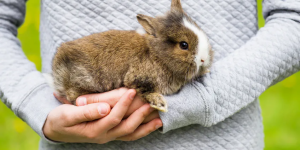
Are you considering a rabbit as a new pet? Rabbits can make wonderful companions and may be the right pet for you. However, contrary to popular belief, they need just as much care and attention — if not more — as cats and dogs do. Let’s talk about a few essentials so you can set yourself and your new furry friend up for success.
Habitat
Rabbits need ample space to express their natural rabbit behaviors, such as running and hopping. A cramped cage is just not sufficient. Rabbits won’t be happy or healthy if they just sit in a tiny cage all day. So, before you go out and purchase a new enclosure for your rabbit, you need to take the rabbit’s size and the cage dimensions into consideration.

Ideally, a whole room or even access to your entire home can become a bunny-friendly environment with proper rabbit-proofing (treating your rabbit like the way you would a pet cat or dog). But you can also set up a large pen enclosure to give your rabbit space while also keeping them out of trouble.
The enclosure size will vary a lot depending on your rabbit breed, but for an average sized rabbit (about 5 lbs), you should aim to have an area of at least 4ft by 2ft.
There are some hutches available that will be big enough, but some people find it easier to use a pen. This makes cleaning your rabbit’s area a lot easier too, because all you have to do is move the gates and vacuum.
You could also consider getting a large dog crate as a rabbit cage. These can be very easy to set up and clean and can offer plenty of space for your rabbit’s home base.
There are a few points you want to look out for, to make sure you avoid getting an enclosure not suitable for rabbits:
- A cage that is too small. The number one thing you want to avoid is getting a cage that is too small for your rabbit. This can lead to some serious health problems in the long run, not to mention a bored and unhappy rabbit.
- A cage with a wire bottom. The wire at the bottom of a cage can cut into a rabbit’s feet and cause sore hocks. If you have a wire cage, you can put a mat down along the bottom to keep them from standing on wire all day.
- A hutch made of painted or toxic wood. Rabbits have an instinct to chew on everything, so they will try to chew on a wooden hutch. This is why you want to avoid any painted wood, and you want to make sure the hutch is not made of a wood that is toxic to rabbits (such as cedar, birch, and yew).
Litterbox
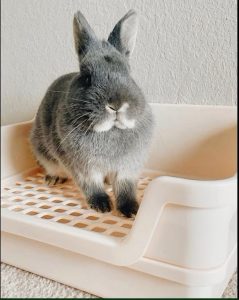
You’ll want to make sure your bunny has a dedicated bathroom area. Many people find that a cat litter box works wonders for their bunnies. Look for one with a low entrance but high sides, so your bunny can hop in easily but is less likely to make a mess. Add some hay to the corners, and your bunny can happily munch while going potty!
Recommended Types of Rabbit Litter
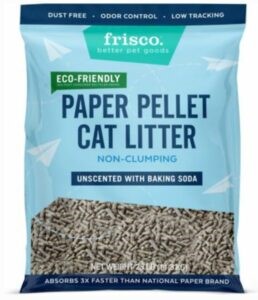
Recycled Paper Litters: This is usually the most reliable and safe option for rabbit litter. Many recycled paper litters are marketed for cats, but they work just as well for rabbits.
Compressed Wood or Sawdust Pellets: Compressed wood or sawdust pellets can be a good, affordable litter option. While Pine and Softwood Shavings should not be used for rabbits, compressed pine and softwood pellets are fine.
Cellulose Fiber Litter: Care Fresh Rabbit Litter is the most popular form of this type of litter. These are safe for your bunny as long as you get the ones without baking soda. The only downside to this litter in our opinion is that is sticks to your bunny’s fur pretty easily and gets everywhere.
Do Not Use

Pine and Cedar Shavings (aka softwood shavings): These types of products are toxic to rabbits and have been shown to cause liver disease. (Pelleted pine is safe).
NEVER use Traditional Clumping Cat Litters: This type of litter is very dangerous when ingested, even inadvertently during grooming. It will cause rock-hard blockages in your rabbit that will have to be surgically removed.
Wheat-type Litters: This type of litter should be avoided because rabbits will often ingest it. Because it is comprised of wheat, it is very high in carbohydrates and can cause obesity, excessive cecal production, diarrhea, bacterial imbalance, and other health issues.
Any Kind of Scented Litter: These types can either cause respiratory issues or make your rabbit just not want to use the litterbox.
Litter training your rabbit can take one to several weeks depending on your rabbit. Some get the idea of using a litter box right away, while others will put up a protest about it.
Nutrition
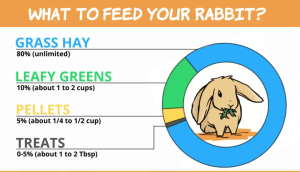
Let’s start with the basics. Having a healthy diet is necessary for your rabbit’s well-being. Rabbits have a very sensitive digestive systems, and problems with their gut is one of the leading causes of illness and death. So, what does a healthy rabbit diet look like?
Hay
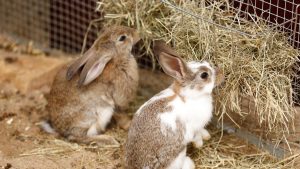
A full 80% of your rabbit’s diet should be grass hay. Timothy hay is best because it is high in fiber and it is rough, making it good for rabbit teeth and digestion. You’ll want to get a big bag of hay and make sure you never let your rabbit run out. Hay keeps their digestive system moving properly and helps them absorb the nutrients their body needs.
Most pet stores, even those that don’t have much in stock for rabbit supplies, will have bags of timothy hay. This is a good and healthy hay to make up the base of your rabbit’s diet, but it’s also a good idea to add in other grass hays, such as orchard, meadow, or oat hay, to add some variety and encourage your rabbit to eat more hay.
Some brands will sell bags of hay that are already mixed, but you can also get the different types of hay separately and mix them together. You could even purchase large bales from local farmers if you want to get the freshest possible hay for your rabbit.
Leafy Greens
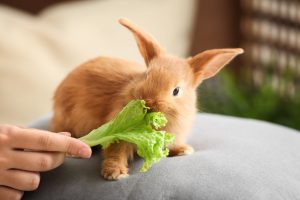
Fresh leafy green vegetables introduce variety and flavor into your rabbit’s diet, while also giving them the nutrients they need to stay healthy. You’ll want to give your rabbit one to five cups of fresh greens daily, depending on how big your rabbit is. You can give this to your rabbit all at once or choose to portion it out over the course of the day.
Most leafy greens that can be found in a grocery store or grown in your garden are safe for your rabbit, but there are some varieties that you should give in smaller quantities, and a few that you should avoid giving your rabbit entirely.
Safe leafy greens for your rabbit:
- Arugula
- Carrot tops
- Leafy lettuces (red, green, romaine)
- Turnip greens
- Dandelion greens
- Mint
- Basil
- Cilantro
- Watercress
- Dill
- Bok choy
Safe for your rabbit, but given in smaller quantities:
- Parsley
- Spinach
- Beet greens
- Mustard greens
Greens to avoid giving your rabbit:
- Iceberg lettuce
- Onion greens
- Silverbeet (Chard)
Pellets
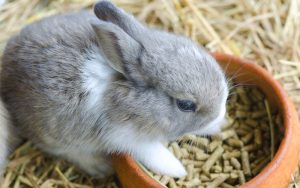
Pellets are not actually necessary for your rabbit’s diet, but they do have some nutritional value and can be a healthy snack. You want to be very strict about the number of pellets they get in a day, based on their weight. Too many pellets can quickly make your rabbit obese, causing a string of health problems. So be sure to avoid giving too many and encourage your rabbit to eat more hay instead.
Grooming
Brushing
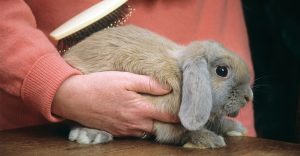
Rabbits shed a lot and you’ll have to brush them to get rid of excess fur. While rabbits shed a little bit all the time, they’ll have two big molting seasons where they shed their winter and summer coats. During this time, there will be clouds of fur, and you’ll need to brush your rabbit more often to keep their fur from getting matted. It also keeps them from ingesting too much fur, preventing blockages in your rabbit’s gut.
Nail Clipping
You will also need to clip your rabbit’s nails. This is a task that is much easier with two people, but it’s possible to do even if you’re a single rabbit parent.
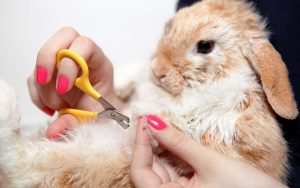
When clipping your rabbit’s nails, you want to look out for the vein, called the quick, that runs up the base of each nail. This is easy to see in rabbits with lighter nails, but it’s more difficult to find in rabbits with thicker or darker nails. In these cases, use the clippers at a spot you think is past the quick. Put some pressure on the nail, but don’t clip all the way through. If the rabbit flinches away, this means you should clip at a spot closer to the tip of the nail.
If you do accidentally clip into the quick, it’s okay. It’s a little painful for the rabbit, and there will probably be a lot of blood, but this is not a serious injury. Your rabbit will recover in no time and wonder why you are making such a fuss.
Enrichment
Toys
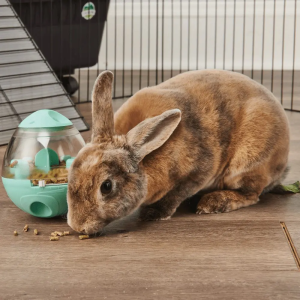
Rabbits are very intelligent animals and they need toys to keep their mind active. You’ll want to look for toys they can throw around, pull on, and dig into. Puzzle toys are also great so they can use their natural foraging instincts to figure out how to get at the treats.
Having appropriate toys is also good for your rabbit’s dental health. Rabbit teeth are open rooted and continue to grow forever. They need lots of hay and chew toys to help keep their teeth from growing out of control and causing health problems. If they’re not given anything to chew on, a rabbit’s teeth could end up growing so much that they can no longer eat.
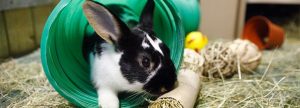
You can also make your own DIY toys out of cardboard boxes and cardboard tubes. You can hide treats inside of the tubes or turn them into hanging toys for your rabbit to play with. Or you can use cardboard boxes to make tunnels and dig play areas for your rabbit.
Games
There are many benefits to playtime with your pet bunny. Not only does it help build a bond between you and your pet, it also provides your rabbit with much needed mental stimulation and exercise. Rabbits enjoy games that cater to their natural tendencies. Here are several you can try:
Nibble & Sprint: Take a small bunch of tasty, scented greens – such as parsley – and sit near your bunnies. Let them come over to investigate and reward them with a little nibble. Then move to another spot and call your rabbits’ names and, when they follow, offer them another tasty titbit. Then pick up the pace and race to another spot and see if they follow (they probably will!). The game can last between five to 10 rounds or until your buns have had enough.
Magic Cups: Take two to three plastic cups (transparent for beginners), your bun’s favorite food, and sit down with your pets. Extra tasty herbs can work well for this game. Place a little food inside the cups and put them upside down on the ground. Now encourage your bunnies to come over to investigate and to get the treat out – you may have to help them figure it out until they’ve got the hang of it. Give them lots of praise when they accomplish it. Add more food and repeat. Make sure you never leave your pet unattended with the plastic cups and don’t let them chew them.
Hopping Challenge: Build a low wall out of cardboard boxes, such as the ones fizzy drink cans come in, and encourage your buns to hop over them by repeating the word “hop” and holding a tasty treat in front of them. When they make the leap, reward them with the treat, along with lots of praise.
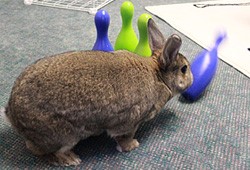
Bunny Bowling: Rabbits enjoy games that cater to their natural tendencies. A game of bunny bowling will appeal to their mischievous side, as they take great delight in knocking things over. Set up some toy bowling pins and watch as your buns nose-bonk them all down.
Chuck It: Some bunnies absolutely love picking up toys with their teeth and tossing them with a flick of their head. Toys for birds are great for this activity because buns can easily grip them. You can also provide cardboard tubes from paper towel or loo paper rolls stuffed with hay.
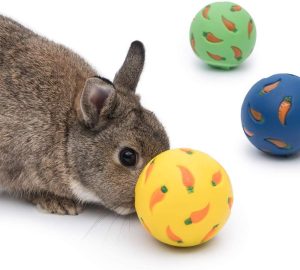
Roll the Ball: Get a small cat ball, preferably one with bells in it, that your rabbits can pick up with their teeth, and roll it towards your pets. After your bunnies have examined the ball, repeat the roll. After a while, you pets may start to bat the ball around with their noses or pick it up with their teeth. If they enjoy this, you may even get to the point where your buns return the ball to you.
Health
In general, rabbits are actually very healthy animals. Most of the time, you will only have to take your rabbit to the vet for their annual check-up. However, there are still a few illnesses and injuries a rabbit can contract that can be potentially life-threatening for our cute fuzzy friends.
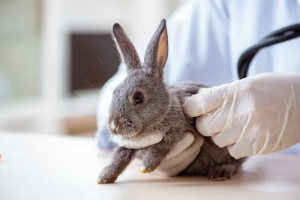
Rabbits are prey animals. To survive, they had to learn how to hide all their weaknesses from predators. Unfortunately, this means it can be difficult to detect when a rabbit isn’t feeling well. You should look out for these symptoms so you can get your rabbit to the vet as soon as possible if needed:
- Lack of appetite, especially if they’re not interested in their favorite treats.
- Lack of energy
- Small or deformed poops
- Not pooping (this is an emergency)
- Sitting in a hunched position
- A change in previously good litter box habits
- A bloated looking belly
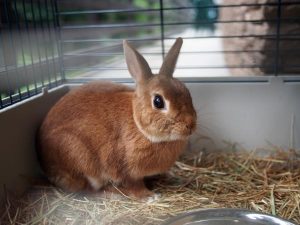
Rabbits can make great pets, but they require a gentle touch, good knowledge of proper care and plenty of attention. Hopefully this beginner Guide got you ready for a new amazing, affectionate, and social pet to join the family.
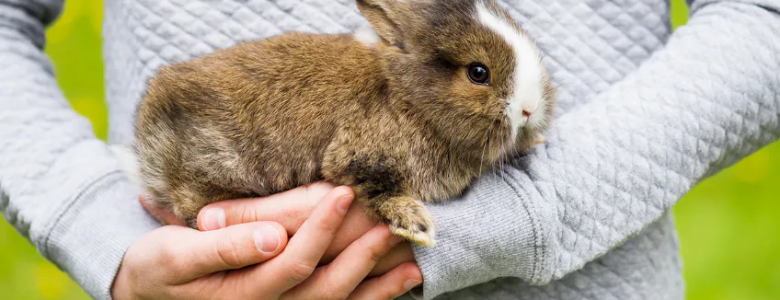




Leave a Reply